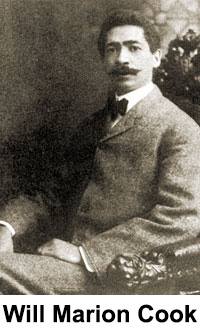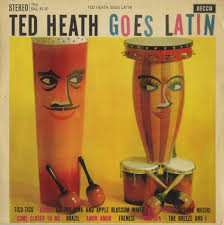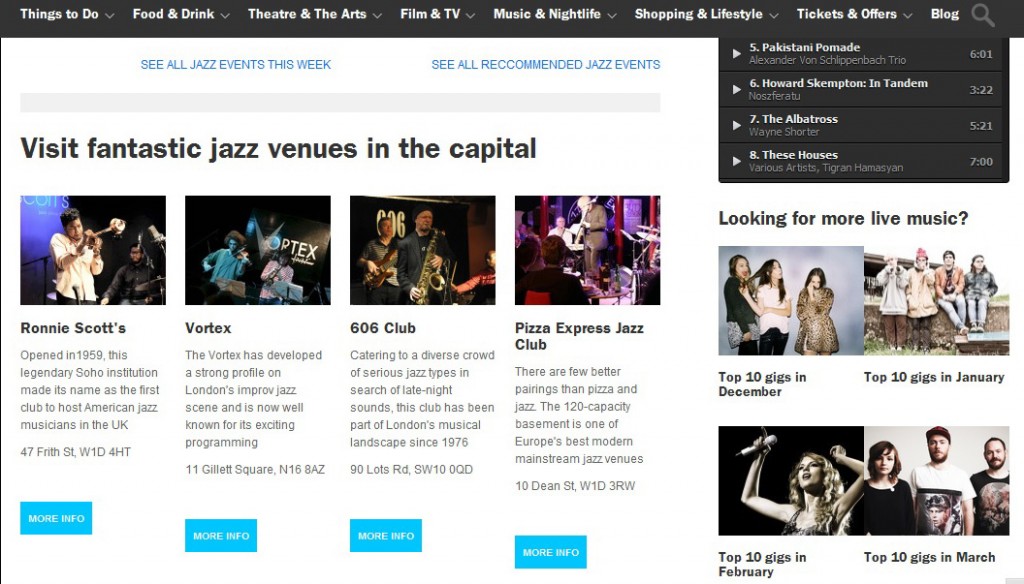A Brief History on London Jazz
Jazz first reached London in 1919 when the Southern Syncopated Orchestra (SSO) from the U.S. embarked on their United Kingdom (UK) tour. Its first performance was at London’s Philharmonic Hall. The orchestra included clarinet virtuoso Sidney Bechet who apparently discovered the soprano saxophone while in London. The excitement of this new musical genre spread through the UK like wildfire and brought a transformation to the London club scene and a newfound public interest in Afro-Caribbean music. Although the scene continued to maintain its popularity, it wasn’t until after the war years that it really began to develop. In the late 1940’s, “modern jazz” started emerging and with British musicians leading the movement, the foundations for the London jazz scene were laid. (http://jazzclubjury.com/jazz-journal/londons-top-5-jazz-clubs/)
The web site of the British Broadcasting Company (BBC) reports:
The SSO was formed by the American composer Will Marion Cook and comprised 27 musicians and 19 singers. The musicians came from New Orleans, New York, Philadelphia, Guyana, Barbados, Antigua and Ghana, among other places. (http://www.bbc.co.uk/london/content/articles/2006/10/09/orchestra_feature.shtml)
 African-American Lt. James Reese Europe, renowned leader of the 369th United States Infantry Band during World War I, known as the “Harlem Hellfighters,” landed in France on New Year’s Day 1918. The band brought the new sound of jazz to the European continent for the first time. What Europe and his “Harlem Hellfighters” were to France and ultimately the rest of Europe, Will Marion Cook and his Southern Syncopated Orchestra were to Britain in 1919 and ultimately the rest of Europe.
African-American Lt. James Reese Europe, renowned leader of the 369th United States Infantry Band during World War I, known as the “Harlem Hellfighters,” landed in France on New Year’s Day 1918. The band brought the new sound of jazz to the European continent for the first time. What Europe and his “Harlem Hellfighters” were to France and ultimately the rest of Europe, Will Marion Cook and his Southern Syncopated Orchestra were to Britain in 1919 and ultimately the rest of Europe.
One of the most important figures in pre-jazz African-American music, Will Marion Cook is also one of its better known personalities. As a composer, conductor, performer, teacher, and producer he had his hand in nearly every aspect of the black music of his time and worked with nearly every other important musician in his fields. To reiterate the above, Cook and his SSO landed in London in 1919, more than a year after James Reese Europe landed in France. 1919 was also the year Europe was killed by one of his own musicians in New York City.
My First Taste of London Jazz
London, England, is the place of my birth. It is also the place where I first heard jazz. I was perhaps eight or nine years old when my father—a classically trained violinist with a radio program on what was then known as BBC’s Third Program—took me to a jazz jamboree somewhere in London. It was the early 1950’s. Jazz was in full “swing” in London by the time I got to hear it for the first time as a very young person.
 I have two clear recollections of that event. First, it was hosted by British comedian Jimmy Edwards (who also played the trombone). Second, the performance was also my first exposure to big band—The Ted Heath Orchestra was one of the featured ensembles. George Edward “Ted” Heath (March 30, 1902 – November 18, 1969) led Britain’s greatest post-war big band, recording more than 100 albums and selling over 20 million records. About the same time, my father was one of several violinists clothed in gypsy garb featured on a very early British Saturday night television variety program called “Café Continental.” Much of the music was Latin or so-called “continental” in nature.
I have two clear recollections of that event. First, it was hosted by British comedian Jimmy Edwards (who also played the trombone). Second, the performance was also my first exposure to big band—The Ted Heath Orchestra was one of the featured ensembles. George Edward “Ted” Heath (March 30, 1902 – November 18, 1969) led Britain’s greatest post-war big band, recording more than 100 albums and selling over 20 million records. About the same time, my father was one of several violinists clothed in gypsy garb featured on a very early British Saturday night television variety program called “Café Continental.” Much of the music was Latin or so-called “continental” in nature.
My family emigrated to the United States in the summer of 1953. I returned to London for only the second time in the summer of 2013 to again visit with family on both my mother’s and father’s side. Familial obligations aside, however, this trip to London was also an opportunity to see and hear first-hand the current jazz scene there several decades after jazz first entered my consciousness.
Seeking Out London Jazz in 2013
In preparation for the visit I asked jazz journalist colleague Howard Mandel, long-time president (and founder) of the Jazz Journalists Association,  who he perceived was the leading jazz journalist in London. The name Sebastian Scotney was proffered.
who he perceived was the leading jazz journalist in London. The name Sebastian Scotney was proffered.
I met with Scotney in London in late May at the Rotunda Restaurant at Kings Place for lunch. He was delightfully affable and clearly possessed a broad knowledge of the London jazz scene and the British jazz scene generally. He has been the editor of “LondonJazz”—a weekly Wednesday, email driven roundup of performance reviews, cd reviews, profiles and interviews, previews, and news and comment—for almost five years. If you’d like to be added to the email list, please contact Scotney at: sebastian@londonjazznews.com.
In addition to “LondonJazz,” he is also (according to his LinkedIn profile) Chair of Trustees of Rosetta Life, a feature writer for Arts Industry Magazine, and a coach for the London Welsh Rugby Football Club (something he’s done for 22 years). Previously, he was a culture blogger for the Telegraph Media Group, a professor of professional skills at the Royal College of Music, CEO of the Jazz Development Trust, an associate with Strategic Partners, an investment bank consultant with Fortis Bank, a managing director with Smith Barney, an equity partner with Dillon Read & Co Inc., and a manager with Williams de Broe. Educated at the University of Oxford (M.A. Modern Languages) and the University of London (M.A. German Studies), Scotney was awarded an Honorary Associateship of the Royal Academy of Music (London) in 2011. Clearly, this was the man to talk to for an overview of the London jazz scene.
His recommendations, given that I had only a little over week left to the trip (with numerous old haunts of my youth to re-connect with), were five clubs: Ronnie Scott’s and Pizza Express (both in the London’s Soho area), the 606 Club in Chelsea, the Vortex in Dalston, and The Bulls Head in Barnes—all sections of London. Given the balance of time available and through Scotney’s good offices, we were able to take in the first three clubs. All three club managers and their public relations contacts were very accommodating, mainly due to Scotney’s well established reputation.
As you might expect, the jazz scene in London, England is as vibrant and varied as it has been since the 1940s when “modern jazz” emerged with British musicians leading the movement,  laying the foundations for the London jazz scene of today.
laying the foundations for the London jazz scene of today.
According to the monthly print version of www.jazzinlondon.net, there are approximately 40 jazz “venues” in London presenting a broad spectrum of jazz styles nightly and weekly. And just as you might expect in a metropolis with a Greater London population of around eight million, so-called jazz venues do not only consist of spaces strictly devoted to the presentation of jazz. Jazz is also presented at such venues at the Friends Life Social Club in Dorking, “Jazz in June” at the Royal Albert Hall, the Royal Academy of Music (Marylebone Road), the St. James Studio at the St. James Theatre, St. Andrew’s United Reformed Church, The Old Rectory Garden (Wavendon), and the Guildhall School of Music & Drama.
London’s jazz scene also boasts a handful of jazz festivals: The Sevenoaks Festival Jazz, the TW12 Jazz Festival, The Mill Hill Music Festival, and the London Jazz Festival held every November just celebrated its 21st year.
There are also schools of jazz in and around London: The Barry Harris Jazz Workshop (“The Keeper of the Bebop Flame”) held at the St. Andrew’s United Reformed Church, the Summer Jazz Course at Oxford University, the International French Jazz School, the Dorgogne International Jazz Summer School, a course in “Songwriting & Recording” held at The Premises Studios, the Belair Jazz Summer School (this one held in Domaine de Bel Air near the Loire region in France), the UK Jazz Summer School held at the Royal Welsh College of Music & Drama, Summer Jazz at the Richmond Jazz School, and a Jazz Summer School held at the Guildhall School of Music & Drama.
 And while not strictly a jazz event in London, there is England’s National Jazz Archive founded by Digby Fairweather, located in Essex, about 90 minutes from Central London. Fairweather is an award-winning British jazz cornettist, recording artist, and broadcaster. The archive consists of books and ephemera, and provides lectures and exhibitions. It is in the process of digitizing its various collections.
And while not strictly a jazz event in London, there is England’s National Jazz Archive founded by Digby Fairweather, located in Essex, about 90 minutes from Central London. Fairweather is an award-winning British jazz cornettist, recording artist, and broadcaster. The archive consists of books and ephemera, and provides lectures and exhibitions. It is in the process of digitizing its various collections.
But just like New York, each club purveys to a different demographic. The style of music from club to club also varied. One element that did punch through with a good measure of consistency, though, was the prominence of Latin rhythms—perhaps a throwback to the Will Marion Cook influence of 94 years prior. If you will recall, his SSO orchestra consisted of musicians from New Orleans, New York, Philadelphia, Guyana, Barbados, Antigua and Ghana, among other places. And as my friend and colleague drummer Bobby Sanabria is fond of pointing out, New Orleans is the Northern most city in the Caribbean.
My impression of the current London jazz scene from direct club experience will be covered in next two blogs.
Please write to me at meiienterprises@aol.com if you have any comments on this or any other of my blogs.
Eugene Marlow, Ph.D.
December 9, 2013
© Eugene Marlow 2013


